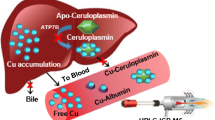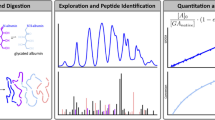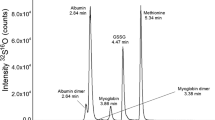Abstract
The ability of human serum albumin to capture unbound copper under different clinical conditions is an important variable potentially affecting homeostasis of this element. Here, we propose a simple procedure based on size-exclusion chromatography with on-line UV and nitrogen microwave-plasma atomic-emission spectrometry (MP-AES) for quantitative evaluation of Cu(II) binding to HSA upon its glycation in vitro. The Cu-to-protein molar ratio for non-glycated albumin was 0.98 ± 0.09; for HSA modified with glyoxal (GO), methylglyoxal (MGO), oxoacetic acid (GA), and glucose (Glc), the ratios were 1.30 ± 0.22, 0.72 ± 0.14, 0.50 ± 0.06, and 0.95 ± 0.12, respectively. The results were confirmed by using ICP-MS as an alternative detection system. A reduced ability of glycated protein to coordinate Cu(II) was associated with alteration of the N-terminal metal-binding site during incubation with MGO and GA. In contrast, glycation with GO seemed to generate new binding sites as a result of tertiary structural changes in HSA. Capillary reversed-phase liquid chromatography with electrospray-ionization quadrupole-time-of-flight tandem mass spectrometry enabled detection and identification of Cu(II) coordinated to the N-terminal metal-binding site (Cu(II)–DAHK) in all tryptic digests analyzed. This is the first report confirming Cu(II)–DAHK species in HSA by means of high-resolution tandem mass spectrometry, and the first report on the use of MP-AES in combination with chromatographic separation.

General scheme designed to study Cu(II) binding to glycated versus non-glycated albumin and MPAESinstrumentation used





Similar content being viewed by others
References
Cooper GJ (2012) Selective divalent copper chelation for the treatment of diabetes mellitus. Curr Med Chem 19:2828–2860
Rodriguez Flores C, Preciado Puga M, Wrobel K, Garay Sevilla ME, Wrobek K (2011) Trace element status in diabetes mellitus 2: possible role of the interaction between molybdenum and copper in the progress of typical complications. Diabetes Res Clin Pract 91:333–341
Valko M, Morris H, Cronin MT (2005) Metals, toxicity and oxidative stress. Curr Med Chem 12:1161–1208
Meyer JA, Spence DM (2009) A perspective on the role of metals in diabetes: past findings and possible future directions. Metallomics 1:32–49
Tanaka A, Kaneto H, Miyatsuka T, Yamamoto K, Yoshiuchi K et al (2009) Role of copper ion in the pathogenesis of type 2 diabetes. Endocr J 56:699–706
Kozlowski H, Janicka-Klos A, Brasun J, Gaggelli E, Valensinc D et al (2009) Copper, iron, and zinc ions homeostasis and their role in neurodegenerative disorders (metal uptake, transport, distribution and regulation). Coord Chem Rev 253:2665–2685
Taverna M, Marie AL, Mira JP, Guidet B (2013) Specific antioxidant properties of human serum albumin. Ann Intensive Care 3:1–7
Argirova MD, Ortwerth BJ (2003) Activation of protein-bound copper ions during early glycation: study on two proteins. Arch Biochem Biophys 420:176–184
Roche M, Rondeau P, Singh NR, Tarnus E, Bourdon E (2008) The antioxidant properties of serum albumin. FEBS Lett 582:1783–1787
Bal W, Sokołowska M, Kurowska E, Faller P (2013) Binding of transition metal ions to albumin: sites, affinities and rates. Biochim Biophys Acta 1830:5444–5455
Rondeau P, Singh NR, Caillens H, Tallet F, Bourdon E (2008) Oxidative stresses induced by glycoxidized human or bovine serum albumin on human monocytes. Free Radic Biol Med 45:799–812
Guerin-Dubourg A, Catan A, Bourdon E, Rondeau P (2012) Structural modifications of human albumin in diabetes. Diabetes Metab 38:171–178
Zhang S, Liu H, Amarsingh GV, Cheung CCH, Hogl S et al (2014) Diabetic cardiomyopathy is associated with defective myocellular copper regulation and both defects are rectified by divalent copper chelation. Cardiovasc Diabetol 13:100–118
Baraka-Vidot J, Navarra G, Leone M, Bourdon E, Militello V et al (2014) Deciphering metal-induced oxidative damages on glycated albumin structure and function. Biochim Biophys Acta 1840:1712–1724
Bettmer J, Bayon MM, Encinar JR, Sanchez MLF, de la Campa MDF et al (2009) The emerging role of ICP–MS in proteomic analysis. J Proteome 72:989–1005
Manley SA, Byrns S, Lyon AW, Brown P, Gailer J (2009) Simultaneous Cu-, Fe-, and Zn-specific detection of metalloproteins contained in rabbit plasma by size-exclusion chromatography-inductively coupled plasma atomic emission spectroscopy. J Biol Inorg Chem 14:61–74
Jin Q, Zhu C, Borer MW, Hieftje GM (1991) A microwave plasma torch assembly for atomic emission spectrometry. Spectrochim Acta B 46:417–430
Sadi BB, Wrobel K, Kannamkumarath SS, Castillo JR, Caruso JA (2002) SEC-ICP-MS studies for elements binding to different molecular weight fractions of humic substances in compost extract obtained from urban solid waste. J Environ Monit 4:1010–1016
El Balkhi S, Poupon JI, Trocello JM, Massicot F, Woimant F et al (2010) Human plasma copper proteins speciation by size exclusion chromatography coupled to inductively coupled plasma mass spectrometry. Solutions for columns calibration by sulfur detection. Anal Chem 82:6904–6910
Cabrera A, Alonzo E, Sauble E, Chu YL, Nguyen D et al (2008) Copper binding components of blood plasma and organs, and their responses to influx of large doses of 65Cu, in the mouse. Biometals 21:525–543
Lopez-Avila V, Sharpe O, Robinson WH (2006) Determination of ceruloplasmin in human serum by SEC-ICPMS. Anal Bioanal Chem 386:180–187
Wang M, Feng W, Lu W, Li B, Wang B et al (2007) Quantitative analysis of proteins via sulfur determination by HPLC coupled to isotope dilution ICPMS with a hexapole collision cell. Anal Chem 79:9128–9134
Eaton JW, Qian M (2002) Interactions of copper with glycated proteins: possible involvement in the etiology of diabetic neuropathy. Mol Cell Biochem 234(235):135–142
Khan MW, Rasheed Z, Khan WA, Ali R (2007) Biochemical, biophysical, and thermodynamic analysis of in vitro glycated human serum albumin. Biochemistry (Mosc) 72:146–152
Qian Y, Zheng Y, Abraham L, Ramos KS, Tiffany-Castiglioni E (2005) Differential profiles of copper-induced ROS generation in human neuroblastoma and astrocytoma cells. Brain Res Mol Brain Res 134:323–332
Thornalley PJ (2005) Dicarbonyl intermediates in the Maillard reaction. Ann N Y Acad Sci 1043:111–117
Rondeau P, Bourdon E (2011) The glycation of albumin: Structural and functional impacts. Biochimie 93:645–658
Polec-Pawlak K, Ruzik R, Lipiec E (2007) Investigation of Cd(II), Pb(II) and Cu(I) complexation by glutathione and its component amino acids by ESI-MS and size exclusion chromatography coupled to ICP-MS and ESI-MS. Talanta 72:1564–1572
Masouka J, Hegenauer J, Van Dyke BR, Saltman P (1992) Intrinsic stoichiometric equilibrium constants for the binding of zinc(II) and copper(II) to the high affinity site of serum albumin. J Biol Chem 268:21533–21537
da Silveira VC, Caramori GF, Abbott MP, Goncalves MB, Petrilli HM et al (2007) Oxindole-Schiff base copper(II) complexes interacions with human serum albumin: spectroscopic, oxidative damage, and computational studies. J Inorg Biochem 103:1331–1341
Trapaidze A, Hureau C, Bal W, Winterhalter M, Faller P (2012) Thermodynamic study of Cu2+ binding to the DAHK and GHK peptides by isothermal titration calorimetry (ITC) with the weaker competitor glycine. J Biol Inorg Chem 17:37–47
(2012 ICH) ICH Harmonized Tripartite Guideline. Validation of analytical procedures: text and methodology (Q2/R1). http://www.ish.org/fileadmin/Public_Web_Site/ICH_Products/Guidelines/Quality/Q2_R1/Step4/Q2_R1_Guideline.pdf
Anguizola J, Matzuda R, Barnaby OS, Hoy KS, Wa C et al (2013) Review: glycation of human serum albumin. Clin Chim Acta 425:64–76
Schmitt A, Gasic-Milenkovic J, Schmitt J (2005) Characterization of advanced glycation end products: mass changes in correlation to side chain modifications. Anal Biochem 346:101–106
Oettl K, Stauber RE (2007) Physiological and pathological changes in the redox state of human serum albumin critically influence its binding properties. Br J Pharmacol 151:580–590
Frolov A, Hoffmann R (2010) Identification and relative quantification of specific glycation sites in human serum albumin. Anal Bioanal Chem 379:2349–2356
Barnaby OS, Cerny RL, Clarke W, Hage DS (2011) Comparison of modification sites formed on human serum albumin at various stages of glycation. Clin Chim Acta 412:277–285
Hureau C, Eury H, Guillot R, Bijani C, Sayen S et al (2011) X-ray and solution structures of Cu(II) GHK and Cu(II) DAHK complexes: influence on their redox properties. Chem Eur J 17:10151–10160
Lapolla A, Fedele D, Reitano R, Arico NC, Seraglia R et al (2004) Enzymatic digestion and mass spectroemtry in the study of advanced glycation end products/peptides. J Am Soc Mass Spectrom 15:496–509
Acknowledgments
The financial support from National Council of Science and Technology, Mexico (CONACYT), projects 178553,187749, 123732, is gratefully acknowledged. The authors also thank for the support from the Ministry of Public Education (PROMEP), project UGTO-PTC-327.
Conflict of interest
The authors declare that they have no conflict of interest.
Author information
Authors and Affiliations
Corresponding author
Electronic supplementary material
Below is the link to the electronic supplementary material.
ESM 1
(PDF 1.98 MB)
Rights and permissions
About this article
Cite this article
Corrales Escobosa, A.R., Wrobel, K., Yanez Barrientos, E. et al. Effect of different glycation agents on Cu(II) binding to human serum albumin, studied by liquid chromatography, nitrogen microwave-plasma atomic-emission spectrometry, inductively-coupled-plasma mass spectrometry, and high-resolution molecular-mass spectrometry. Anal Bioanal Chem 407, 1149–1157 (2015). https://doi.org/10.1007/s00216-014-8335-1
Received:
Revised:
Accepted:
Published:
Issue Date:
DOI: https://doi.org/10.1007/s00216-014-8335-1




